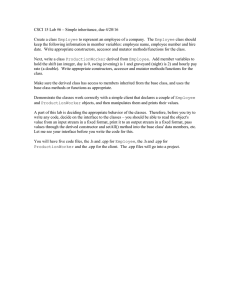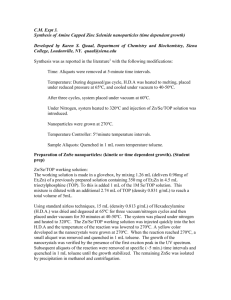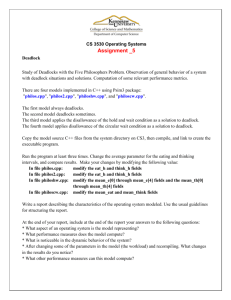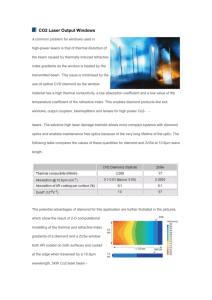Chromium-doped zinc selenide gain media: From Please share
advertisement
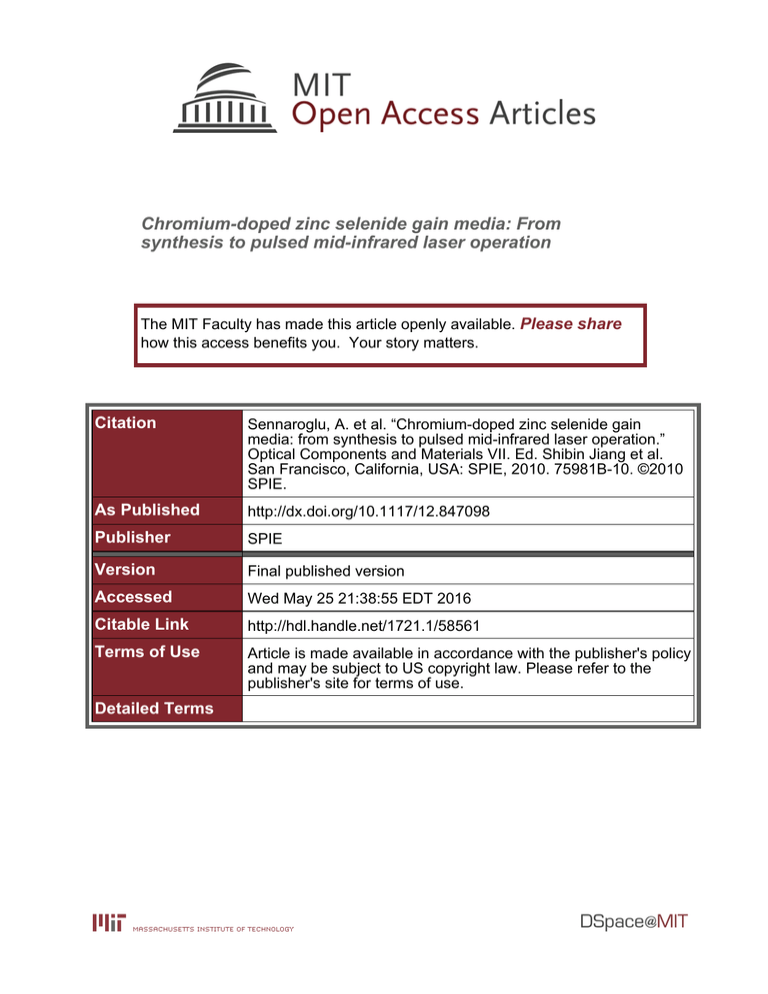
Chromium-doped zinc selenide gain media: From
synthesis to pulsed mid-infrared laser operation
The MIT Faculty has made this article openly available. Please share
how this access benefits you. Your story matters.
Citation
Sennaroglu, A. et al. “Chromium-doped zinc selenide gain
media: from synthesis to pulsed mid-infrared laser operation.”
Optical Components and Materials VII. Ed. Shibin Jiang et al.
San Francisco, California, USA: SPIE, 2010. 75981B-10. ©2010
SPIE.
As Published
http://dx.doi.org/10.1117/12.847098
Publisher
SPIE
Version
Final published version
Accessed
Wed May 25 21:38:55 EDT 2016
Citable Link
http://hdl.handle.net/1721.1/58561
Terms of Use
Article is made available in accordance with the publisher's policy
and may be subject to US copyright law. Please refer to the
publisher's site for terms of use.
Detailed Terms
Invited Paper
Chromium-doped zinc selenide gain media: From synthesis to pulsed
mid-infrared laser operation
A. Sennaroglu*a, U. Demirbasa,b, H. Cankayaa, N. Cizmeciyana, A. Kurtc, and M. Somerd
Laser Research Laboratory, Department of Physics, Koç University, Rumelifeneri Yolu,
Sarıyer, 34450, İstanbul, Turkey
b
Department of Electrical and Computer Engineering, Massachusetts Institute of Technology,
Cambridge, MA, 02139, USA
c
Teknofil, Inc., Zekeriyaköy, İstanbul, 34450, Turkey
d
Department of Chemistry, Koç University, Rumelifeneri, Sarıyer, İstanbul, 34450, Turkey
a
ABSTRACT
This paper provides an overview of the experimental work performed in our research group on the synthesis,
spectroscopic investigation, and laser characterization of chromium-doped zinc selenide (Cr2+:ZnSe). By using diffusion
doping, 40 polycrystalline Cr2+:ZnSe samples with ion concentration in the range of 0.8 × 1018 to 66 × 1018ions/cm3
were prepared. From the absorption data, temperature-dependent diffusion coefficient of chromium and losses at the
lasing wavelength were measured. In luminescence measurements, the concentration dependence of the fluorescence
lifetime and fluorescence quantum efficiency was determined. During continuous-wave operation, the optimum
concentration for lasing was determined to be 8.5 × 1018 ions/cm3 at an incident pump power of 2.1 W for 1800-nm
pumping. During gain switched operation, intra-cavity pumping with a 1570-nm optical parametric oscillator resulted in
continuous tuning between 1880 and 3100 nm. By employing dispersion compensation with a MgF2 prism pair, Kerrlens mode-locked operation was also demonstrated at 2420 nm, resulting in the generation of 95-fs pulses with an
average output power of 40 mW and spectral bandwidth of 69 nm. The time-bandwidth product of the pulses was further
measured to be 0.335 close to the expected value of 0.315 for sech2 pulses.
Keywords: Tunable solid-state lasers, chalcogenide lasers, Cr2+:ZnSe lasers, diffusion doping, Kerr-lens mode locking,
mid-infrared lasers, II-VI compound semiconductors, solid state spectroscopy.
1. INTRODUCTION
The spectroscopic properties of II-VI compound semiconductors (such as ZnSe, ZnS, CdTe, and others, also referred to
as chalcogenides) doped with transition metal (TM) ions such as Cr2+ and Fe2+ have long been known1-9. In particular,
introducing TM ions into these hosts leads to the formation of strong absorption and emission bands in the mid infrared
region of the electromagnetic spectrum. In late 1990s, pioneering work performed at the Lawrence Livermore National
Laboratories further demonstrated laser action in Cr2+:ZnSe and Cr2+:ZnS10, 11 near 2500 nm. Since then, lasing has been
observed in numerous TM ion-doped chalcogenides12-20. One of the most extensively studied members of this class of
solid-state lasers is Cr2+:ZnSe. It possesses several favorable spectroscopic properties that make it an important source
of coherent radiation in the mid infrared region around 2.5 μm. These include 1) nearly unity luminescence quantum
efficiency at room temperature, 2) broad absorption band near 1800 nm which allows optical pumping with Tm- and Erbased lasers, among others, 3) absence of excited-state absorption at the lasing wavelength around 2400 nm, and 4)
presence of a vibronically broadened emission band extending over the 2-3 μm region which is suitable for the
generation of mode-locked pulses with sub-20-fs duration. An additional unique feature of Cr2+:ZnSe is that diffusion
doping can be employed to prepare doped, laser-active samples at very low cost by using commercially available ZnSe
substrates21-23.
*
asennar@ku.edu.tr; phone: 90 212 338 1429; fax: 90 212 338 1559
Optical Components and Materials VII, edited by Shibin Jiang,
Michel J. F. Digonnet, John W. Glesener, J. Christopher Dries, Proc. of SPIE
Vol. 7598, 75981B · © 2010 SPIE · CCC code: 0277-786X/10/$18 · doi: 10.1117/12.847098
Proc. of SPIE Vol. 7598 75981B-1
Downloaded from SPIE Digital Library on 29 Jul 2010 to 18.51.1.125. Terms of Use: http://spiedl.org/terms
Cr2+:ZnSe lasers have several potentially important applications, one of which is high harmonic generation24. Recent
studies show that it is possible to increase the cut-off wavelength of harmonics in the deep ultraviolet and soft x-ray
region by using femtosecond excitation lasers with longer central wavelengths in the mid infrared25. Such wavelengths
can be attained by using nonlinear wavelength conversion schemes26-29. Alternatively, Cr2+:ZnSe or other chalcogenide
lasers can be employed to directly generate laser radiation at these long wavelengths. Other potential applications of
Cr2+:ZnSe lasers include spectroscopy, pumping of optical parametric oscillators or Raman gain media to attain even
longer wavelengths in the mid infrared and the development of mid-infrared optical combs for frequency metrology.
Extensive review of the development and applications of chalcogenide lasers may be found in Refs. 30-34.
To date, different modes of operation have been demonstrated with Cr2+:ZnSe lasers. These include gain switched10, 11,
continuous-wave (cw) tunable35, actively mode-locked36, 37, passively mode-locked38-40 and microchip laser 41 operations
with as high as multi-watt cw output powers42, 43. Furthermore, by employing intra-cavity pumping, the broadest tuning
range reported to date spans the 1.88-3.1 μm region44.
This paper provides an overview of the experimental work conducted in our research group at Koç University, İstanbul,
Turkey aimed at the synthesis and characterization of Cr2+:ZnSe for laser applications. Section 2 first describes the
preparation of polycrystalline Cr2+:ZnSe samples by using the method of thermal diffusion doping. Spectroscopic
characterization involved the measurement of the absorption/emission spectra, passive losses at the lasing wavelength,
determination of the temperature dependence of the diffusion coefficient in ZnSe, fluorescence quantum efficiency as a
function of doping concentration, and fluorescence lifetime as a function of concentration. In Sections 3 and 4, we
discuss the cw and gain-switched operations of Cr2+:ZnSe lasers at room temperature. In particular, intra-cavity pumping
with an optical parametric oscillator (OPO) resulted in a broad tuning range extending from 1880 to 3100 nm.
Furthermore, we experimentally determined the optimum ion concentration for cw lasing. Finally, Section 5 summarizes
our recent ultrashort pulse generation experiments where 95-fs pulses were generated at 2420 nm by using the method of
Kerr-lens mode locking.
2. SYNTHESIS AND SPECTROSCOPIC CHARACTERIZATION
OF POLYCRYSTALLINE Cr2+:ZnSe
Thermal diffusion doping was employed to prepare the Cr2+:ZnSe samples used in this study23. In particular, in each
doping run, a polycrystalline ZnSe substrate with a diameter of 10 mm and thickness of 2.0 mm was placed together with
CrSe dopant powder inside an evacuated (pressure < 10–5 mbar) silica ampoule and heated to temperatures in the 8001100 0C range. The diffusion time of samples was varied between 6 hours and 43 days. Altogether, about 40 Cr2+:ZnSe
samples were prepared with different peak absorption coefficients (at 1775 nm) in the range of 0.9-76 cm-1. The average
Cr2+ ion concentration of each sample was estimated by using the absorption cross-section value reported by Vallin (σabs
= 1.15x10-18 cm2 at 1775 nm)6. The average Cr2+ ion concentration of the samples varied in the range of 0.8x1018-66x1018
ions/cm3.
Thermal diffusion doping leads to a non-uniform dopant distribution inside the crystal. By measuring the variation of the
absorption coefficient as a function of position and by using a three-dimensional diffusion model, we further determined
the diffusion coefficient D for chromium ions inside ZnSe for samples prepared at different temperatures. At 1000 0C, D
was determined to be 5.4 x 10-10 cm2/s for Cr2+:ZnSe. The temperature dependence of D was further measured between
800 and 1100 0C23.
By using the absorption spectra and by subtracting the Fresnel losses, we further determined the variation of the passive
losses near 2500 nm as a function of active ion concentration. This is a very important parameter to characterize in an
actual laser since the lasing threshold as well as the slope efficiency of the laser depend on the level of passive losses.
From the absorption measurements performed with more than 10 polycrystalline samples, the differential loss coefficient
α2500 at 2500 nm (in units of cm-1) of the Cr2+:ZnSe samples was found to increase approximately linearly with average
Cr2+ concentration (denoted as NCr (ions/cm-3 )) according to the empirical relation45
α 2500 ≈ (0.04 ± 0.02) + {(0.02 ± 0.01) x 10−18}N Cr .
Proc. of SPIE Vol. 7598 75981B-2
Downloaded from SPIE Digital Library on 29 Jul 2010 to 18.51.1.125. Terms of Use: http://spiedl.org/terms
(1)
The concentration dependence of losses could be due to defects introduced during diffusion, other impurities such as Fe
in the dopant, or self absorption46-50. Note that there is a residual loss of 0.04±0.02 cm-1 at low doping levels possibly due
to scattering.
In order to investigate the effect of doping concentration on fluorescence strength, we measured the fluorescence lifetime
and fluorescence efficiency of the Cr2+:ZnSe samples. In the lifetime measurements, a 1570-nm, KTP optical parametric
oscillator (OPO) was used. The OPO generated 65-ns pulses at a pulse repetition rate of 1 kHz. The time-dependent
fluorescence of the samples was monitored by using an InGaAs detector with a response time of 3 ns. Measurements
performed with twenty-six Cr2+:ZnSe samples of varying active ion concentration show that the fluorescence lifetime
decreases monotonically with active ion concentration as was observed in earlier studies21, 51. Furthermore, the
concentration dependence of the fluorescence lifetime (τF) could be fitted to an empirical formula of the form45
τF =
τ F0
⎛ N ⎞2
1 + ⎜ Cr ⎟
⎝ N0 ⎠
,
(2)
where τF0 is the fluorescence lifetime at low doping levels, NCr is the chromium ion concentration, and N0 is the
concentration where τF is reduced to τF0/2. The best-fit values of τF0 and N0 were determined to be 5.56 μs and 17x1018
ions/cm3. Since the reduction in the fluorescence lifetime stems from non-radiative decay that increases with
concentration, we see that samples with Cr2+ concentration less than approximately 10x1018 ions/cm3 (corresponding
peak absorption coefficient of 11.5 cm-1 at 1775 nm) are less susceptible to non-radiative losses during cw operation.
Phonon-assisted non-radiative decay is another source of unwanted loss during lasing. To characterize this further, we
also measured the temperature dependence of the fluorescence lifetime for a Cr2+:ZnSe sample with Cr2+ concentration of
5.7 x1018 ions/cm3, where concentration-dependent non-radiative decay is minimal. For temperatures above 60 °C, we
observed a sharp increase in nonradiative decay rates similar to previous studies10, 21, 51. The temperature dependence of
the fluorescence lifetime at low doping concentrations could be obtained from the empirical equation45
⎛ ΔE ⎞
1
1
1
1
1
=
+
=
+
Exp⎜−
⎟,
τ F (T) τ R τ NR (T) τ R τ NR0
⎝ kBT ⎠
(3)
where τF(T) is the temperature-dependent fluorescence lifetime, τR-1 is the spontaneous radiative decay rate, τNR(T)-1 is
the temperature-dependent nonradiative decay rate, τNR0 is the high temperature limit of the nonradiative decay rate, ΔE
is the activation energy, kB is Boltzmann’s constant and T is the absolute temperature in degrees Kelvin. The best-fit
values of τNR0 and ΔE were determined to be 0.63 ps and 4260 cm-1, respectively, for Cr2+:ZnSe. Furthermore, the critical
temperature (defined as T1/2 in ref52) at which the fluorescence lifetime drops to half of the radiative lifetime comes to
115 °C. Hence, for local temperatures below 1000C and doping levels less than 10x1018 ions/cm3, undesirable effects due
to non-radiative decay should be relatively low.
We further carried out fluorescence efficiency measurements to estimate the optimum doping concentration for cw
lasing. In these measurements, a home-built cw Cr4+:YAG laser at 1510 nm and a commercial cw thulium fiber laser at
1800 nm (IPG Photonics) were used as excitation sources. In both cases, lock-in detection was employed together with a
0.5-m Czerny-Turner type monochromator and a PbS detector to measure the variation of the fluorescence as a function
of wavelength. To obtain a quantitative measure for the emission strength of the samples, we experimentally determined
the fluorescence efficiency ηF at 2400 nm, defined as
ηF =
I 2400
,
Pabs
(4)
where I2400 is the measured fluorescence intensity at 2400 nm and Pabs is the absorbed pump power at the excitation
wavelength (1510 nm or 1800 nm). Note that although the measured fluorescence signal here is in arbitrary units, this
method alows for a comparison of the fluorescence efficiency from different samples. Results showed that a sharp
decrease in the fluorescence efficiency occurred with increasing Cr2+ concentration in agreement with the lifetime data.
We could obtain a good fit to the fluorescence efficiency data by using the following empirical formula for ηF45:
Proc. of SPIE Vol. 7598 75981B-3
Downloaded from SPIE Digital Library on 29 Jul 2010 to 18.51.1.125. Terms of Use: http://spiedl.org/terms
⎡N ⎤
F
⎥.
⎣ N Cr ⎦
ηF = a ln⎢
(5)
Clearly, the above formula is valid for doping concentrations below NF. The fitting parameters a and NF were determined
to be 0.1725 and 68.4x1018 ions/cm3 (corresponding peak absorption coefficient at 1775 nm= 78.5 cm-1), respectively.
Spectroscopic data presented so far can be used to estimate the optimum chromium concentration Nopt which maximizes
the fluorescence power at the lasing wavelength for a given pump power. Nopt also depends on the sample length. The
total emitted power at the lasing wavelength will be proportional to AηF, where A is the absorption in a sample of length
l and is given by A=1-exp(-σaNCr l ). Here, σa is the absorption cross section and NCr is the chromium ion
concentration. As NCr increases, A monotonically increases and approaches unity at large doping levels. The product AηF,
on the other hand, attains a local maximum and then decreases to zero as NCr is varied. By using the best-fit parameters
obtained from the experimentally measured fluorescence efficiency data, our simple model predicts that for a 2-mm-long
sample, the optimum chromium concentration is about 6x1018 ions/cm3 (corresponding peak absorption coefficient at
1775 nm=6.9 cm-1). Furthermore, we find that the calculated optimum ion concentration decreases as the sample length
is increased as can be seen from Fig. 1. Physically, this makes sense because as the sample length is increased, lower ion
concentration still provides enough absorption and at the same time, the fluorescence efficiency remains high.
Figure 1. Calculated variation of the optimum chromium concentration and the corresponding fluorescence strength AηF (in arbitrary
units) as a function of the sample length for polycrystalline Cr2+:ZnSe.
3. CONTINUOUS-WAVE LASER PERFORMANCE
A more direct way to determine the optimum ion concentration involves evaluating the cw laser performance of the
samples with different concentrations. The setup shown in Fig. 2 was used for this purpose. The astigmatically
compensated x-cavity containing each Cr2+:ZnSe sample was end pumped with a cw 5-W thulium fiber laser (IPG
Photonics) at 1800 nm. An input converging lens (L1, f=10 cm) focused the pump beam inside the gain medium. The
resonator consisted of two curved high reflectors (M1 and M2, R=10 cm) around the gain medium, a flat end high
reflector (HR), and a 3 % flat output coupler (OC). Each sample was held in a copper holder and water cooled at 15 °C.
Laser operation was obtained in the free-running mode with a center wavelength near 2500 nm.
Proc. of SPIE Vol. 7598 75981B-4
Downloaded from SPIE Digital Library on 29 Jul 2010 to 18.51.1.125. Terms of Use: http://spiedl.org/terms
Figure 2. Schematic of the continuous-wave thulium-fiber pumped Cr2+:ZnSe laser.
We experimentally investigated the cw power performance of nine Cr2+:ZnSe samples with Cr2+ concentration in the 0.823.2 x1018 ions /cm3 range. The thickness of each sample was around 2 mm. For consistency, only those samples
prepared at the diffusion temperature of 1000 0C were used. Different diffusion times were used to vary the active ion
concentration from sample to sample. Results showed that laser performance depends strongly on the active ion
concentration as was expected from the spectroscopic results. It is important to note that in a practical laser system, the
optimum concentration also depends on the pumping level since thermal effects are related to the amount of nonradiative decay. For example, pumping at 2.1 W of incident pump power, the sample producing the maximum output
power of approximately 165 mW had a Cr2+ concentration of 8.5x1018 ions/cm3. Detailed experimental measurements of
threshold power, slope efficiency, and output power showed that for samples with chromium concentration outside the
range of 4-10x1018 ions/cm3, the chromium concentration is either too low to have sufficient pump absorption, or too
high to produce efficient fluorescence, in reasonable agreement with the spectroscopic predictions. This range
corresponds to a peak absorption coefficient of 4.6-11.5 cm-1 at 1775 nm45. In the cw regime, continuous tuning could be
obtained from 2240 to 2900 nm by using a Brewster-cut MgF2 prism53.
4. GAIN-SWITCHED OPERATION OF Cr2+:ZnSe LASERS
We also investigated gain-switched operation of Cr2+:ZnSe lasers54. Here, to obtain the broadest tuning range possible,
we employed intra-cavity pumping inside the resonator of a pulsed KTP OPO operating at 1570 nm44. The KTP OPO
was end-pumped with a Q-switched Nd:YAG laser which generated 145-ns pulses at a pulse repetition rate of 1 kHz at
1064 nm. The output of the OPO was then focused inside a 2-mm-long Cr2+:ZnSe sample which was prepared by using
diffusion doping at 10000C. The diffusion time was 6 days, resulting in a doping concentration of 5.7x1018 ions/cm3,
fluorescence lifetime of 5 μs, and a small signal absorption of 43 % at 1570 nm. Low pump absorption was necessary
for obtaining simultaneous oscillation at 1570 nm and for tuning below 2000 nm where re-absorption is a limiting factor.
The Cr2+:ZnSe laser was an astigmatically compensated x-cavity in which a Brewster-cut sapphire prism was used to
tune the output. The pump beam at 1570 nm transmitted through the Cr2+:ZnSe sample was retroreflected to extend the
resonator of the OPO and to include the Cr2+:ZnSe gain medium. When properly aligned, intracavity-pumped lasing
could be obtained with this composite cavity. At the output wavelength of 2.6 μm, up to 145 μJ of energy was obtained
per pulse with a 25 % output coupler. The repetition rate was 1 kHz. The total incident Nd:YAG pump energy used was
1.8 mJ. By using 4 different sets of optics and the sapphire tuning prism, the output wavelength could be continuously
tuned from 1880 to 3100 nm.
5. KERR-LENS MODE-LOCKED OPERATION OF Cr2+:ZnSe LASERS
In recent experiments, we also demonstrated Kerr-lens mode-locked operation of a Cr2+:ZnSe laser and generated
femtosecond pulses near 2400 nm55. Different from the studies described in the previous sections, a commercial, 2.4mm-long Cr2+:ZnSe single crystal was used as the gain medium. A schematic of the experimental setup is shown in Fig.
3. The astigmatically compensated x-cavity containing the Cr2+:ZnSe crystal at Brewster incidence was end-pumped
with a thulium fiber laser at 1800 nm. The total small-signal absorption of the gain medium was 94% at 1800 nm. In the
mode locking experiments, an output coupler with a transmission of 1% (at 2400 nm) was used. The total cavity length
was 159 cm. Dispersion compensation was achieved with a pair of Brewster-cut MgF2 prisms.
Proc. of SPIE Vol. 7598 75981B-5
Downloaded from SPIE Digital Library on 29 Jul 2010 to 18.51.1.125. Terms of Use: http://spiedl.org/terms
Figure 3. Schematic of the Kerr-lens mode-locked femtosecond Cr2+:ZnSe laser.
Figure 4 further shows the cw power performance of the Cr2+:ZnSe laser in the free-running mode and with the MgF2
prism pair. With the 1% output coupler, the laser produced up to 150mW of output power in the free-running mode at an
incident pump power of 2.67 W. The slope efficiency was 6.7%. The estimated round-trip passive loss due to the crystal
and resonator optics was further determined to be 3.65 %. Inclusion of the prism pair reduced the maximum available
output power to about 100 mW due to the poor surface quality of the prisms. The tip-to-tip separation of the prisms was
set to 8.5 cm during mode locking experiments. The overall round-trip dispersion of the resonator including the gain
medium, prism pair, and prism insertion was estimated to be -1700fs2 at 2420 nm. Note that the zero-dispersion
wavelength for MgF2 is around 1.35 μm and at 2420 nm, the dispersion contribution coming from the prism material is
also negative. Dispersion estimates were made by using the Sellmeier equations for ZnSe and MgF2 from Ref.56.
Figure 4. Continuous-wave power efficiency curves for the Cr2+:ZnSe laser in the free running mode and with the MgF2 prism pair.
The output wavelength is near 2400 nm.
After the focusing within the gain medium was optimized, Kerr-lens mode-locked operation could be obtained by
translating the output coupler. Sample autocorrelation and spectrum of the generated pulses are shown in Figs.5 and 6,
respectively. The collinear autocorrelation of the pulses was measured via two-photon absorption in a germanium
detector. For this particular example, the autocorrelation width ( τ AC in Fig. 5) was 156 fs, giving a pulse duration
(FWHM) of 103 fs by assuming a sech2 pulse profile. The spectral width was 66 nm, resulting in a time-bandwidth
product of 0.347. This is in good agreement with what is expected (0.315) for a transform-limited sech2 pulse. Further
optimization of the focusing and cavity dispersion resulted in the generation of pulses as short as 95 fs with a timebandwidth product of 0.335 at 2420 nm55.
Proc. of SPIE Vol. 7598 75981B-6
Downloaded from SPIE Digital Library on 29 Jul 2010 to 18.51.1.125. Terms of Use: http://spiedl.org/terms
Figure 5. Collinear autocorrelation of the mode-locked femtosecond pulses generated at 2414 nm with the Cr2+:ZnSe laser.
Figure 6. Spectrum of the mode-locked pulses generated at 2414 nm with the Cr2+:ZnSe laser.
By using the optimized pulsewidth (95 fs) and energy data obtained during mode-locked operation, we also estimated the
nonlinear refractive index of the Cr2+:ZnSe gain medium from the equation57, 58
τ=
4D
Wδ
.
(6)
Above, τ is the pulse duration (FWHM) divided by 1.76 (54.1fs), |D| is the magnitude of group delay dispersion (GDD~1700fs2), W is the intra-cavity pulse energy (42nJ), and the nonlinearity coefficient δ is given by
δ=
2π n2 l
.
λ Aeff
(7)
In Eq. (7), n2 is nonlinear refractive index, l is the crystal length, λ is the vacuum wavelength, and Aeff is the effective
beam area which we approximately took as π(ω0)2rms, ((ω0)rms=rms spot size in the gain medium=32 μm). From this
Proc. of SPIE Vol. 7598 75981B-7
Downloaded from SPIE Digital Library on 29 Jul 2010 to 18.51.1.125. Terms of Use: http://spiedl.org/terms
simple analysis, n2 for Cr2+:ZnSe was determined to be 1.4x10-14cm2/W, in good agreement with previously reported
value (1.7x10-14cm2/W)31.
6. CONCLUSIONS
In conclusion, we provided a brief review of the work conducted in our reserach group on the synthesis and
characterization of diffusion-doped Cr2+:ZnSe for mid-infrared laser applications. Spectroscopic analysis shows that
samples with dopant concentration in the 4-10x1018 ions/cm3 range are less immune to non-radiative decay porcesses and
should be suitable for a wide range of laser applications. Diffusion-doped polycrystalline samples were used to
demonstrate cw and gain-switched lasing. Intra-cavity pumping with a 1570-nm KTP OPO resulted in continuous tuning
from 1880 to 3100 nm. Kerr-lens mode locking was further demonstarted with a single-crystal Cr2+:ZnSe sample and 95fs pulses were generated at 2420 nm. These studies demonstrate the versatility of the Cr2+:ZnSe gain medium for
different regimes of laser operation in the 2-3 μm wavelength region.
ACKNOWLEDGMENTS
This project was supported by the Network of Excellence in Micro-Optics (NEMO) funded by the European Union 6th
Framework program (2004-2008) and by the Scientific and Technological Research Council of Turkey (TUBITAK)
under projects TBAG-2030 and 108T028.
REFERENCES
1.
2.
3.
4.
5.
6.
7.
8.
9.
10.
11.
12.
13.
G. A. Slack, F. S. Ham, and R. M. Cherenko, "Optical Absorption of Tetrahedral Fe2+ (cd6) in Cubic ZnS,
CdTe, and MgAl2O4," Physical Review 152(1), 376-402 (1966).
G. A. Slack and B. M. Omera, "Infrared Luminescence of Fe2+ in ZnS," Physical Review 163(2), 335-341
(1967).
G. A. Slack, S. Roberts, and F. S. Ham, "Far-Infrared Optical Absorption of Fe2+: in ZnS," Physical Review
155(2), 170-177 (1967).
J. M. Baranowski, J. W. Allen, and G.L.Pearson, "Crystal-Field Spectra of 3dn Impurities in II-VI and III-V
Compound Semiconductors," Physical Review 160(3), 627-632 (1967).
H. Nelkowski and G. Grebe, "IR-luminescence of ZnS:Cr," Journal of Luminescence 1-2, 88-93 (1970).
J. T. Vallin, G. A. Slack, S. Roberts, and A. E. Hughes, "Infrared Absorption in Some II-VI Compounds Doped
with Cr," Physical Review B 2(11), 4313-4333 (1970).
G. Grebe, G. Roussos, and H.-J. Schulz, "Infrared luminescence of ZnSe:Cr crystals," Journal of Luminescence
12-13, 701-705 (1976).
M. Godlewski and M. Kaminska, "The chromium impurity photogeneration transitions in ZnS, ZnSe and
ZnTe," Journal of Physics C: Solid State Physics 13, 6537-6545 (1980).
G. Roussos, H.-J. Schulz, and M. Thiede, "Luminescence and related optical properties of iron ions in II-VI
componds," Journal of Luminescence 31-32(1), 409-411 (1984).
L. D. DeLoach, R. H. Page, G. D. Wilke, S. A. Payne, and W. F. Krupke, "Transition Metal-Doped Zinc
Chalcogenides Spectroscopy and Laser Demonstration of a New Class of Gain Media," IEEE Journal of
Quantum Electronics 32(6), 885-895 (1996).
R. H. Page, J. A. Skidmore, K. I. Schaffers, R. J. Beach, S. A. Payne, and W. F. Krupke, "Demonstrations of
diode-pumped grating-tuned ZnSe:Cr+2 lasers," presented at the OSA TOPS, Advanced Solid-State Lasers,
Orlando, 1997.
I. T. Sorokina, E. Sorokin, A. D. Lieto, M. Tonelli, B. N. Mavrin, and E. A. Vinogradov, "A new broadly
tunable room temperature continuous-wave Cr2+:ZnSxSe1-x laser," presented at the Advanced Solid State
Photonics, Vienna, Austria, 2005.
J. McKay, K. L. Schepler, and G. C.Catella, "Efficient grating-tuned mid-infrared Cr2+:CdSe laser," Optics
Letters 24(22), 1575-1577 (1999).
Proc. of SPIE Vol. 7598 75981B-8
Downloaded from SPIE Digital Library on 29 Jul 2010 to 18.51.1.125. Terms of Use: http://spiedl.org/terms
14.
15.
16.
17.
18.
19.
20.
21.
22.
23.
24.
25.
26.
27.
28.
29.
30.
31.
32.
33.
34.
35.
36.
37.
A. G. Bluiett, U. Hommerich, R. T. Shah, S. B. Trivedi, S. W. Kutcher, and C. C. Wang, "Observation of lasing
from Cr2+:CdTe and compositional effects in Cr2+-doped II-VI semiconductors," Journal of Electronic Materials
31(7), 806-810 (2002).
U. Hommerich, X. Wu, V. R. Davis, S. B. Trivedi, K. Grasza, R. J. Chen, and S. Kutcher, "Demonstration of
room-temperature laser action at 2.5 μm from Cr2+:Cd0.85Mn0.15Te," Optics Letters 22(15), 1180-1182 (1997).
S. B. Trivedi, S. W. Kutcher, C. C. Wang, G. V. Jagannathan, U. Hommerich, A. Bluiett, M. Turner, J. T. Seo,
K. L. Schepler, B. Schumm, P. R. Boyd, and G. Green, "Transition metal doped cadmium manganese telluride:
a new material for tunable mid-infrared lasing," Journal of Electronic Materials 30(6), 728-732 (2001).
P. Cerny, H. Sun, D. Burns, U. N. Roy, and A. Burger, "Spectroscopic investigation and continuous wave laser
demonstration utilizing single crystal Cr2+:CdZnTe," presented at the Advanced Solid-State Photonics, Vienna,
Austria, 2005.
J. J. Adams, C. Bibeau, R. H. Page, D. M. Krol, L. H. Furu, and S. A. Payne, "4.0-4.5 μm lasing of Fe: ZnSe
below 180 K, a new mid-infrared laser material," Optics Letters 24(23), 1720-1722 (1999).
A. A. Voronov, V. I. Kozlovsky, Y. V. Korostelin, A. I. Landman, Y. P. Podmar'kov, Y. K. Skasyrsky, and M.
P. Frolov, "A continuous-wave Fe2+ : ZnSe laser," Quantum Electronics 38(12), 1113-1116 (2008).
V. V. Fedorov, S. B. Mirov, A. Gallian, D. V. Badikov, M. P. Frolov, Y. V. Korostelin, V. I. Kozlovsky, A. I.
Landman, Y. P. Podmar'kov, V. A. Akimov, and A. A. Voronov, "3-77-5.05-μm tunable solid-state lasers based
on Fe2+-doped znse crystals operating at low and room temperatures," IEEE Journal of Quantum Electronics
42(9), 907-917 (2006).
A. Burger, K. Chattopadhyay, J. O. Ndap, X. Ma, S. H. Morgan, C. I. Rablau, C. H. Su, S. Feth, R. H. Page, K.
I. Schaffers, and S. A. Payne, "Preparation conditions of chromium doped ZnSe and their infrared luminescence
properties," Crystal Growth 225, 249-256 (2001).
J. O. Ndap, K. Chattopadhyay, O. O. Adetunji, D. E. Zelmon, and A. Burger, "Thermal diffusion of Cr2+ in bulk
ZnSe," Journal of Crystal Growth 240, 176-184 (2002).
U. Demirbas, A. Sennaroglu, and M. Somer, "Sythesis and characterization of diffusion-doped Cr2+:ZnSe and
Fe2+:ZnSe," Optical Materials 28, 231-240 (2006).
T. Brabec and F. Krausz, "Intense few-cycle laser fields: Frontiers of nonlinear optics," Reviews of Modern
Physics 72(2), 545-591 (2000).
A. Gordon and F. X. Kartner, "Scaling of keV HHG photon yield with drive wavelength," Optics Express 13(8),
2941-2947 (2005).
D. Brida, M. Marangoni, C. Manzoni, S. De Silvestri, and G. Cerullo, "Two-optical-cycle pulses in the midinfrared from an optical parametric amplifier," Optics Letters 33(24), 2901-2903 (2008).
J. Moses, C. Manzoni, S. W. Huang, G. Cerullo, and F. X. Kartner, "Temporal optimization of ultrabroadband
high-energy OPCPA," Optics Express 17(7), 5540-5555 (2009).
C. Erny, C. Heese, M. Haag, L. Gallmann, and U. Keller, "High-repetition-rate optical parametric chirped-pulse
amplifier producing 1-mu J, sub-100-fs pulses in the mid-infrared," Optics Express 17(3), 1340-1345 (2009).
C. Erny, L. Gallmann, and U. Keller, "High-repetition-rate femtosecond optical parametric chirped-pulse
amplifier in the mid-infrared," Applied Physics B-Lasers and Optics 96(2-3), 257-269 (2009).
T. J. Carrig, "Transition-Metal-Doped Chalcogenide Lasers," Journal of Electronic Materials 31(7), 759-769
(2002).
I. T. Sorokina, "Crystalline Mid-Infrared Lasers," in Solid-State Mid-Infrared Laser Sources, I. T. Sorokina and
K. L. Vodopyanov, eds. (Springer, Berlin Heidelberg, 2003), pp. 255-349.
I. T. Sorokina, "Cr2+-doped II-VI materials for lasers and nonlinear optics," Optical Materials 26, 395-412
(2004).
E. Sorokin, I. T. Sorokina, C. Fischer, and M. W. Sigrist, "Widely tunable Cr2+:ZnSe laser source for trace-gas
sensing," presented at the Advanced Solid State Photonics, Vienna, Austria, 2005.
S. Kück, "Laser-related spectroscopy of ion-doped crystals for tunable solid-state lasers," Applied Physics B 72,
515-562 (2001).
G. J. Wagner, T. J. Carrig, R. H. Page, K. I. Schaffers, J. Ndap, X. Ma, and A. Burger, "Continuous-wave
broadly tunable Cr2+:ZnSe laser," Optics Letters 24(1), 19-21 (1999).
T. J. Carrig, G. J. Wagner, A. Sennaroglu, J. Y. Jeong, and C. R. Pollock, "Mode-locked Cr2+:ZnSe laser,"
Optics Letters 25(3), 168-170 (2000).
I. T. Sorokina, E. Sorokin, A. D. Lieto, M. Tonelli, R. H. Page, and K. I. Schaffers, "Active and passive modelocking of the Cr+2:ZnSe laser," presented at the Advanced Solid-State Lasers, Munich, 2001.
Proc. of SPIE Vol. 7598 75981B-9
Downloaded from SPIE Digital Library on 29 Jul 2010 to 18.51.1.125. Terms of Use: http://spiedl.org/terms
38.
39.
40.
41.
42.
43.
44.
45.
46.
47.
48.
49.
50.
51.
52.
53.
54.
55.
56.
57.
58.
C. R. Pollock, N. A. Brilliant, D. Gwin, T. J. Carrig, W. J. Alford, J. B. Heroux, W. I. Wang, I. Vurgaftman,
and J. R. Meyer, "Mode locked and Q-switched Cr: ZnSe laser using a Semiconductor Saturable Absorbing
Mirror (SESAM)," presented at the Advanced Solid State Photonics, Vienna, Austria, 2005.
I. T. Sorokina, E. Sorokin, T. J. Carrig, and K. I. Scaffers, "A SESAM passively mode-locked Cr:ZnSe laser,"
presented at the Advanced Solid-State Photonics, Incline Village, Nevada, 2006.
I. T. Sorokina, E. Sorokin, and T. Carrig, "Femtosecond Pulse Generation from a SESAM Mode-Locked
Cr:ZnSe Laser," presented at the Conference on Lasers and Electro-Optics (CLEO), Long Beach, California,
2006.
S. B. Mirov, V.V.Fedorov, K. Graham, I. S. Moskalev, V. V. Badikov, and V. Panutin, "CW and Pulsed Cr2+
:ZnSe and ZnSe Microchip Lasers," presented at the CLEO, 2002.
I. S. Moskalev, V. V. Fedorov, and S. B. Mirov, "Tunable, single-frequency, and multi-watt continuous-wave
Cr2+: ZnSe lasers," Optics Express 16(6), 4145-4153 (2008).
I. S. Moskalev, V. V. Fedorov, and S. B. Mirov, "10-Watt, pure continuous-wave, polycrystalline Cr2+:ZnS
laser," Optics Express 17(4), 2048-2056 (2009).
U. Demirbas and A. Sennaroglu, "Intracavity-pumped Cr2+: ZnSe laser with ultrabroad tuning range between
1880 and 3100 nm," Optics Letters 31(15), 2293-2295 (2006).
A. Sennaroglu, U. Demirbas, A. Kurt, and M. Somer, "Direct experimental determination of the optimum
chromium concentration in continuous-wave Cr2+: ZnSe lasers," IEEE Journal of Selected Topics in Quantum
Electronics 13(3), 823-830 (2007).
G. F. Neumark, "Defects in wide band gap II-VI crystals," Materials Science and Engineering R21, 1-46
(1997).
G. Goetz, H. Zimmermann, and H.-J. Schulz, "Jahn-Teller interaction at Cr2+(d4) centers in tetrahedrally
coordinated II-VI lattices studied by optical spectroscopy," Zeitschrift Für Physik B 91, 429-236 (1993).
C. I. Rablau, J. O. Ndap, X. Ma, A. Burger, and N. C. Giles, "Absorption and Photoluminescence Spectroscopy
of Diffusion-Doped ZnSe:Cr2+," Electronic Materials 28(6), 678-682 (1999).
A. V. Podlipensky, V. G. Shcherbitsky, N. V. Kuleshov, V. I. Levchenko, V. N. Yakimovich, M. Mond, E.
Heumann, G. Huber, H. Kretschmann, and S. Kück, "Efficient laser operation and continuous-wave didode
pumping of Cr2+:ZnSe single crystals," Applied Physics B, 253-255 (2001).
I. T. Sorokina, E. Sorokin, A. D. Lieto, M. Tonelli, R. H. Page, and K. I. Schaffers, "Efficient broadly tunable
continuous-wave Cr2+:ZnSe laser," Journal of the Optical Society of America B 18(7), 926-930 (2001).
V. E. Kisel, V. G. Shcherbitsky, N. V. Kuleshov, V. I. Konstantinov, V. I. Levchenko, E. Sorokin, and I. T.
Sorokina, "Spectral kinetic properties and lasing characteristics of diode-pumped Cr2+:ZnSe single crystals,"
Optics and Spectroscopy 99(4), 663-667 (2005).
M. Stalder, M. Bass, and B. H. T. Chai, "Thermal Quenching of Fluorescence in Chromium-Doped Fluoride
Laser Crystals," Journal of the Optical Society of America B-Optical Physics 9(12), 2271-2273 (1992).
A. Sennaroglu, U. Demirbas, N. Vermeulen, H. Ottevaere, and H. Thienpont, "Continuous-wave broadly
tunable Cr2+ : ZnSe laser pumped by a thulium fiber laser," Optics Communications 268(1), 115-120 (2006).
A. Sennaroglu, U. Demirbas, A. Kurt, and M. Somer, "Concentration dependence of fluorescence and lasing
efficiency in Cr2+ : ZnSe lasers," Optical Materials 29(6), 703-708 (2007).
M. N. Cizmeciyan, H. Cankaya, A. Kurt, and A. Sennaroglu, "Kerr-lens mode-locked femtosecond Cr2+:ZnSe
laser at 2420 nm," Optics Letters 34(20), 3056-3058 (2009).
M. Bass, Handbook of Optics, 2nd Edition ed. (McGraw-Hill, 1994), Vol. 2.
H. A. Haus, "Mode-Locking of Lasers," IEEE Journal of Quantum Electronics 6, 1173-1185 (2000).
F. X. Kartner, I. D. Jung, and U. Keller, "Soliton mode-locking with saturable absorbers," IEEE Journal of
Selected Topics in Quantum Electronics 2(3), 540-556 (1996).
Proc. of SPIE Vol. 7598 75981B-10
Downloaded from SPIE Digital Library on 29 Jul 2010 to 18.51.1.125. Terms of Use: http://spiedl.org/terms

